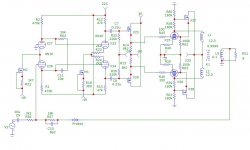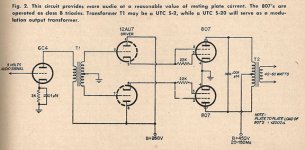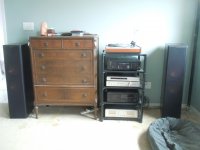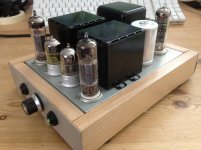My definitive recipe for an amazing bedroom amp is as follows:
-Use ECL82 in a PP, but use Russian 6F3P as a quad of winged C can be had for the same price as a typical single western ECL82.
-Use garter bias on the output stage which will give you around 5watts of class A. Triode strap the pentodes.
-Use Antek 10-20VA toroidal power transformers as OT
-use the two triode's as a LTP up front (this will benefit from some sort of negative supply to stiffen the tail), Drive one side and use the other as a gNFB point from the OT secondary.
-Use a Florescent light ballast as a choke in the power supply.
-filter the input with a LPF below 40hz and use a small dedicated active sub for 10-40hz signals.
This should be a very simple, cheap and compact amplifier which can be housed in either an old recycled transistor amplifier case, or as I did in a 1U rack mount case, and will depend on how much you were prepared to use salvaged parts. I find dead PC PSU units make excellent donors of 250V caps for this scale of amp.
This should be powerful enough to drive even standard bookshelf speakers of 88db/w efficiency to bedroom listening levels.
Such a design could be made for about €100 depending on how much the power transformer could be sourced for.
Shoog
-Use ECL82 in a PP, but use Russian 6F3P as a quad of winged C can be had for the same price as a typical single western ECL82.
-Use garter bias on the output stage which will give you around 5watts of class A. Triode strap the pentodes.
-Use Antek 10-20VA toroidal power transformers as OT
-use the two triode's as a LTP up front (this will benefit from some sort of negative supply to stiffen the tail), Drive one side and use the other as a gNFB point from the OT secondary.
-Use a Florescent light ballast as a choke in the power supply.
-filter the input with a LPF below 40hz and use a small dedicated active sub for 10-40hz signals.
This should be a very simple, cheap and compact amplifier which can be housed in either an old recycled transistor amplifier case, or as I did in a 1U rack mount case, and will depend on how much you were prepared to use salvaged parts. I find dead PC PSU units make excellent donors of 250V caps for this scale of amp.
This should be powerful enough to drive even standard bookshelf speakers of 88db/w efficiency to bedroom listening levels.
Such a design could be made for about €100 depending on how much the power transformer could be sourced for.
Shoog
Last edited:
Shoog, I am amazed to read of successfully using global feedback from the secondary of a power transformer; have you ever scoped it? What size of compensation caps are you having to use, typically?
The high impedance grid tends to act as an antenna.
I would usually connect it to a low-impedance source. However I know some grid-leak-bias amps driven by crystal microphones and insignificant garbage.
But I don't mean to doubt your observation.
Shoog, I am amazed to read of successfully using global feedback from the secondary of a power transformer; have you ever scoped it? What size of compensation caps are you having to use, typically?
I do it all the time. I typically use 1000pf||2k connected from the output to the midpoint of the first stage cathode resistors (cathode, 330, 68, Gnd. 330 bypassed with 1000uF).
For a low power amp, you don't need to double the transformers (interleaved primaries, series secondaries) but the LF power out will be low 15W@1kHz, 2.4W@20Hz... Doubling the coils will get you 15W@25Hz.
I have a pair of these speakers, and they are useable down to ~40Hz and they are 4s! No need for a subwoofer in my case. a 7W SE amp will drive them loud enough, but 50W is better 🙂
Micca RB42 Reference Bookshelf Speakers | Micca Electronics
No, I didn't do AB2. I'm thinking if you used a good driver AB2 would be a fun direction to go. Fixed bias with some small TO-92 mosfets maybe? Easy peasy if you already have a DC supply for the filaments.
Hmmmm...
Hmmmm...
My 3W Amp
One of several I've built this version uses 6AU6/6AQ5 in a FB pair. It is completely integrated with Baxandal Tone Controls & a Magnetic Pickup Preamp on board. The 12AX7 preamp heater can be shut down when not in use. Built in 1968 it runs everyday with separate Eico AM & FM Receivers.in the workshop. Think the 6AQ5 has been replaced once. Imagine that for reliability.The PS is SS, the rectifier diodes are Philips Top Hats from another era.
Unlike many other amps on DIY this one is completely documented with real test data. All built inside a Hammond 8x12x3 steel chassis.🙂
One of several I've built this version uses 6AU6/6AQ5 in a FB pair. It is completely integrated with Baxandal Tone Controls & a Magnetic Pickup Preamp on board. The 12AX7 preamp heater can be shut down when not in use. Built in 1968 it runs everyday with separate Eico AM & FM Receivers.in the workshop. Think the 6AQ5 has been replaced once. Imagine that for reliability.The PS is SS, the rectifier diodes are Philips Top Hats from another era.
Unlike many other amps on DIY this one is completely documented with real test data. All built inside a Hammond 8x12x3 steel chassis.🙂
Attachments
-
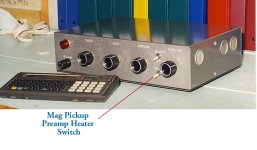 3 WATT AMP Preamp Heater Switch.jpg104.6 KB · Views: 168
3 WATT AMP Preamp Heater Switch.jpg104.6 KB · Views: 168 -
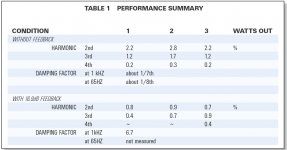 3 Watt Amp Performance Summary.jpg98.5 KB · Views: 109
3 Watt Amp Performance Summary.jpg98.5 KB · Views: 109 -
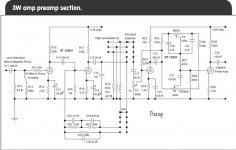 3 Watt Amp Preamp & Tone Controls.jpg114.9 KB · Views: 173
3 Watt Amp Preamp & Tone Controls.jpg114.9 KB · Views: 173 -
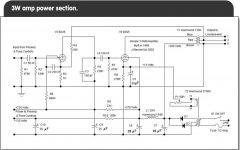 3 Watt Amp Power Output & Power Supply.jpg106.4 KB · Views: 174
3 Watt Amp Power Output & Power Supply.jpg106.4 KB · Views: 174 -
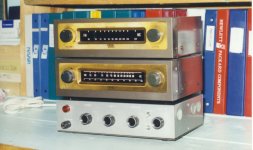 3 WATT AMP w Eico.jpg92.7 KB · Views: 169
3 WATT AMP w Eico.jpg92.7 KB · Views: 169 -
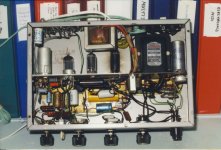 3 WATT AMP Bottom.jpg118.5 KB · Views: 171
3 WATT AMP Bottom.jpg118.5 KB · Views: 171
No, I didn't do AB2. I'm thinking if you used a good driver AB2 would be a fun direction to go. Fixed bias with some small TO-92 mosfets maybe? Easy peasy if you already have a DC supply for the filaments.
Hmmmm...
I've been thinking about building at least 1 tube amp so read much on the subject and like the idea of low ( = "enough") power combined with a sensitive FR speaker. You're spot on about the mosfet drivers for AB2 - according to simulations that works very well. No "speed bump" re THD but continuing the curve as expected, just higher power and efficiency. In that line of thought (having 4k OT w/o UL connections) I also played with an alternative, ULX.
Attachments
Shoog, I am amazed to read of successfully using global feedback from the secondary of a power transformer; have you ever scoped it? What size of compensation caps are you having to use, typically?
The assumption seems to be that response will be poor so compensation will be difficult. I have found that a toroidal will have better response than many dedicated OTs if attention is given to eliminating DC. That is what the garter bias is for.
Shoog
Yes, I have found too that mains transformers give excellent results with low impedance tubes; I myself use current sinks to eliminate DC, as far as possible. My assumption was that the unavoidable shunt capacitance would have lowered the resonant frequency to the point that global feedback would be problematic.,
The only down side with grid leak bias is that it is inherently more noisy, it will always hiss and pop more than a conventional cathode resistor.
Shoog
The reason is not so much the high impedance so easily picking up interference. After all you tend to have a low impedance source.
It is the thermal noise in such high resistance as well as the shot noise due to the grid current in the old carbon comp resistor. A modern metal film will have the same thermal noise but very little of the 'pop' in shot noise.
You could be right on that.piano3
You could also take the feedback from the plate of the output tube.
I generally use CCS for my DC balance, but when dealing with such low power garter works equally well and is minimally wasteful. I have seen people suggest garter for 6AS7 PP which is horribly wasteful and expensive to achieve.
Shoog
Last edited:
Hi minhaj,
I don't know about you, but since those awful radios in he 60's, I have had much better stuff driving much better speakers. My tastes have evolved even if yours have not. Joe is looking for something high quality that doesn't have to go very loud. But, nothing wrong if it does. With tubes, distortion rises with increasing power levels, so having something that is very low distortion at low volumes would be a benefit. In my book anyway.
Joe,
In my bedroom system (I use a Luxman M02 / C02 / T-03 system (150 wpc) driving a pair of newer Klipsch dual 8" towers (99 dB / watt). I run it quiet at night and while watching thee TV monitor. In the morning I run it louder on the radio, and even louder on the CD. Mostly 'cause I can 🙂 . I modified all the equipment for higher performance. I had to fix it anyway as the amp was blown and overheated.
Sure it's a bit over the top, but I love great music and I was able to trade something for the system. Also, there is a 1930's table radio (tombstone style) radio we listen to some times. So I have that range covered I guess.
I completely support your project, but given the opportunity, build something with lower distortion that can handle musical peaks (10:1 ratio to average power, 15:1 on good CDs). A low powered single ended will compress peaks and you will hear it after a while. Sorry, that's the math and reality of it.
I think a little P-P 6BQ5 amplifier would keep everyone happy for the duration. The output transformers will be less expensive and it will probably run cooler than a single ended amplifier that puts out much more than 2 watts. Remember, there was a very good reason why old tube equipment went to P-P in the better units. They sounded a lot better.
-Chris
I don't know about you, but since those awful radios in he 60's, I have had much better stuff driving much better speakers. My tastes have evolved even if yours have not. Joe is looking for something high quality that doesn't have to go very loud. But, nothing wrong if it does. With tubes, distortion rises with increasing power levels, so having something that is very low distortion at low volumes would be a benefit. In my book anyway.
Joe,
In my bedroom system (I use a Luxman M02 / C02 / T-03 system (150 wpc) driving a pair of newer Klipsch dual 8" towers (99 dB / watt). I run it quiet at night and while watching thee TV monitor. In the morning I run it louder on the radio, and even louder on the CD. Mostly 'cause I can 🙂 . I modified all the equipment for higher performance. I had to fix it anyway as the amp was blown and overheated.
Sure it's a bit over the top, but I love great music and I was able to trade something for the system. Also, there is a 1930's table radio (tombstone style) radio we listen to some times. So I have that range covered I guess.
I completely support your project, but given the opportunity, build something with lower distortion that can handle musical peaks (10:1 ratio to average power, 15:1 on good CDs). A low powered single ended will compress peaks and you will hear it after a while. Sorry, that's the math and reality of it.
I think a little P-P 6BQ5 amplifier would keep everyone happy for the duration. The output transformers will be less expensive and it will probably run cooler than a single ended amplifier that puts out much more than 2 watts. Remember, there was a very good reason why old tube equipment went to P-P in the better units. They sounded a lot better.
-Chris
Attachments
One of several I've built this version uses 6AU6/6AQ5 in a FB pair. It is completely integrated with Baxandal Tone Controls & a Magnetic Pickup Preamp on board. The 12AX7 preamp heater can be shut down when not in use. Built in 1968 it runs everyday with separate Eico AM & FM Receivers.in the workshop. Think the 6AQ5 has been replaced once. Imagine that for reliability.The PS is SS, the rectifier diodes are Philips Top Hats from another era.
Unlike many other amps on DIY this one is completely documented with real test data. All built inside a Hammond 8x12x3 steel chassis.🙂
That is a very nice design Mr. Stewart! That cathode biasing on the second tube puzzle me: why did you do the bias adjusting this way? Is there a specific reason for that? If I am correctly interpreting it of course.
Hi Joe,
Just my 2 cents, I had a bedroom amp years ago with ECL82 in triode-mode, it would output no more than 1 WATT of power, very tiny amp, build on old CD-ROM chassis. With this much power only speakers with sensitivity higher than 92-94 db would actually work.
So, I would start backwards and check what speakers you going to drive - and then select the power tube, voltage and all that, just to save you from disappointment of just not having enough power to drive your speakers... it's not only about total power but synergy of amp-speakers at those small power levels...
Just my 2 cents, I had a bedroom amp years ago with ECL82 in triode-mode, it would output no more than 1 WATT of power, very tiny amp, build on old CD-ROM chassis. With this much power only speakers with sensitivity higher than 92-94 db would actually work.
So, I would start backwards and check what speakers you going to drive - and then select the power tube, voltage and all that, just to save you from disappointment of just not having enough power to drive your speakers... it's not only about total power but synergy of amp-speakers at those small power levels...
Attachments
Hi Joe,
Just my 2 cents, I had a bedroom amp years ago with ECL82 in triode-mode, it would output no more than 1 WATT of power, very tiny amp, build on old CD-ROM chassis. With this much power only speakers with sensitivity higher than 92-94 db would actually work.
So, I would start backwards and check what speakers you going to drive - and then select the power tube, voltage and all that, just to save you from disappointment of just not having enough power to drive your speakers... it's not only about total power but synergy of amp-speakers at those small power levels...
At this moment I am using in the "bedroom" (it is in fact one of our bedrooms which I am using as my "man cave" 😀 )
two Lenco HIFI 880 speakers driven by my Sansui AU555A 25 W amplifier (my first buy back in 1971, still in use 🙂).
I am intending to use these two speakers.
Isn't there a risk with a home built tube amplifier, after Barry White has worked his magic, that you will fall asleep before switching off?
In the office we had timer switches for electrical appliances like kettles. Having left my amps on once too often, I wonder if there is something similar for home use. Ideal would be a shutdown after 1 hour of no signal.
In the office we had timer switches for electrical appliances like kettles. Having left my amps on once too often, I wonder if there is something similar for home use. Ideal would be a shutdown after 1 hour of no signal.
Hi Joe,
I see, maybe for your speakers would be better to use D-class amp, always on with little power waste but enough power reserve.
Otherwise something like this on youtube: Lenco ICES HI FI 880 with 3 tube amp - YouTube
I see, maybe for your speakers would be better to use D-class amp, always on with little power waste but enough power reserve.
Otherwise something like this on youtube: Lenco ICES HI FI 880 with 3 tube amp - YouTube
Last edited:
So, I would start backwards and check what speakers you going to drive - and then select the power tube, voltage and all that, just to save you from disappointment of just not having enough power to drive your speakers... it's not only about total power but synergy of amp-speakers at those small power levels...
+1 on working backwards from the speakers... but I would say its not at all about having enough power. Its all about if I can still hear a balanced frequency range with it playing at no more than 40db of volume, the sound level of a light rain. The kids are asleep, we are relaxing, but I don't want the sound of my bedroom amp to become like that of a pocket transistor radio simply because I want to play it at a whisper volume. I still want to hear the bass player and the ride cymbal full range. This is where a $69 Amazon Echo cylinder smart speaker excels greatly in the bedroom, they sound amazing at
bedtime listening levels. But its not tubes which is annoying.
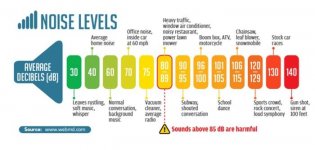
- Home
- Amplifiers
- Tubes / Valves
- low power bedroom amp
